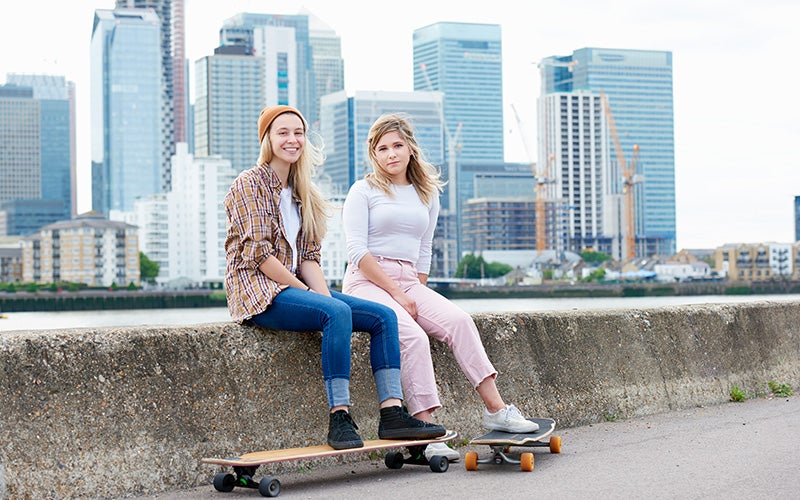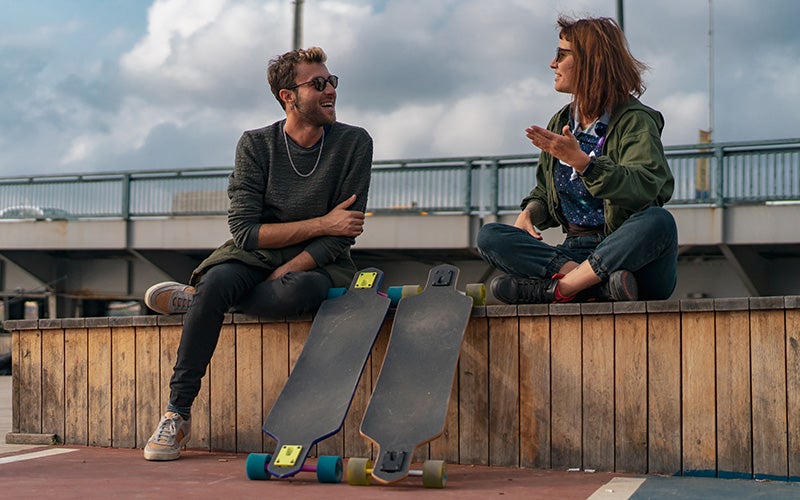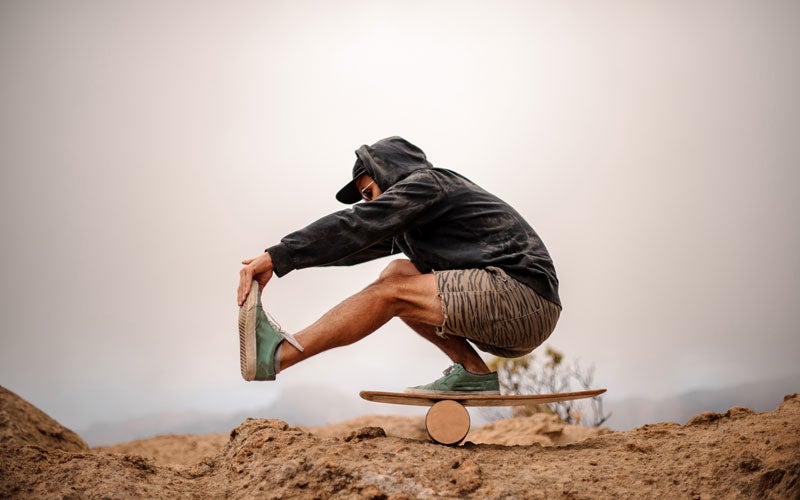The best longboarding tips for beginners
 ©We Are
©We Are
No other sport offers as much freedom and fun as longboarding. If you dream of skating around town and doing tricks with your friends, then maybe it’s time you learn how to longboard. Keep reading to find out everything you need to know to get started!
What Is Longboarding?
A longboard is composed of a deck and two trucks that are equipped with two wheels each. Longboards can range in length from 90 and 150 centimeters, and their widths vary between 17 and 25 centimeters.
Longboards are sold in many different shapes. The ends of the board — also known as the nose and the tail — can be round or pointed. Some versions have cutouts in the nose and tail — these are called drop-throughs. Another type, called kicktails, has a nose and tail that both curve upward. Pintails and twin tips are two of the most popular shapes. The former has a tail that’s narrow and tapers to a point. The latter has symmetrical ends that feature cutouts for the shafts.
The size, shape, and flexibility of the board will determine its riding characteristics. Some boards are better suited for casual riding, others for slaloms — aka winding routes with obstacles — and others for tricks. Keep reading to find out more about these different styles.
Not sure which board is right for you? In general, beginners should consult an expert before making your final choice. Keep in mind that you’ll usually get more stability from a board with a longer deck, though it will be trickier to maneuver.
What is the difference between a longboard and a skateboard?
At about 80 x 20 centimeters on average, skateboards are a lot shorter than longboards. With tails and noses that are almost always symmetrical and rounded, they also have a very different shape. Though a skateboard is usually better for tricks than longboards are, they won’t go nearly as fast.

What Muscles Does Longboarding Train?
Longboarding demands as much from the body as snowboarding, surfing, slacklining, or skateboarding. This trendy board sport is the ultimate balance workout.
Here are some possible positive effects longboarding can have:
- It can improve balance and awareness of the body.
- It can help develop concentration and coordination.
- It can stabilize joints.
- It compensates for imbalances and prevents back pain and tension.
- It improves posture.
- In particular, it can strengthen the core and back muscles.
Longboarding definitely isn’t a competition. It’s all about getting out in the fresh air and flexing your social skills. Instead of worrying about who’s going the fastest, longboarders encourage their fellow riders and have a good time while they’re at it.
Interested in finding other group sports? Click here to find out more about skateboarding and parkour!
Our tip: Longboarding is fun, but also requires a lot of energy. Need a nutritious snack for the road? We’ve got just what you need! Our Protein Balls are the great source of protein to have in your pocket. Delicious, convenient, and shareable!
How Does Longboarding Work?
Learning how to longboard can be difficult at first, especially in the balancing department. All it takes is consistent practice to gain confidence and agility. Look for a group of skaters to teach you the rope. In the end you’ll learn a few tricks and maybe make some friends along the way!
Make sure you’re ready for your first longboarding attempts with these tips:
#1 Stand on your longboard
Use your front foot to control balance and your back foot to gain momentum. Your foot should be turned at a 45-degree angle to the board and your back foot should be turned at a 90-degree angle.
Don’t know which leg is your most stable? Ask someone to push you forward. The foot you use to hold yourself up from falling is the foot you need to put forward on the longboard. Otherwise, just try both sides. It won’t take long for you to figure out which foot feels better in the front.
#2 Gain stability
Once you’ve figured out which foot goes where, it’s time to start working on stability. Find a paved path with a smooth surface and stand in the middle of your board. Bend your knees slightly to shift your weight back and forth. Try a few different foot positions and vary the distance between your feet without getting off the board.
While riding, the distance between your feet will depend on how you move forward. The wider the space between your feet, the more stable you’ll be on the board. For steep descents, spread your legs wider than shoulder-width apart.
#3 Try it out for the first time
Place your front foot firmly on the board and push yourself off the ground with your back foot. As soon as you start to roll, place your back foot on board and let yourself roll. When you start to lose momentum, push yourself off again with your back foot. It’s best to make your first few attempts on a flat surface.
As soon as you start to feel confident, you can try riding down a gentle slope. Let yourself roll without stopping to get used to the momentum.
#4 Learn to brake
Learning to brake is just as important as learning to ride. The easiest way to brake is to place your back foot lightly on the ground. This creates friction between the sole of your shoe and the ground, which causes you to slow down and eventually stop completely.
This is the easiest way to brake but definitely not the only way. In fact, advanced longboarders have a bunch of braking methods in their repertoire. As you get more comfortable with the simplest method, have an experienced longboarding buddy show you more techniques.
#5 Practice turning
You don’t always need to go straight when longboarding. You can steer by shifting your weight to your heels (this is known as a heel side turn) or your toes (aka a toe side turn). The side you lean to determines which way you’ll go. Start by practicing this on gentle slopes and hills so that you can focus on the direction instead of the momentum and gradually gain control.

The Different Longboarding Styles
Not all longboarding styles are the same. Depending on your mood, there are plenty of different ways to ride. Here are some examples and terms to help you get started.
- Pushing: This involves continuously pushing with your back foot while riding long distances, usually on relatively flat surfaces.
- Cruising: This refers to riding your longboard straight ahead on flat lanes and slightly inclined trails.
- Carving: Carving is the next level up from cruising and it’s all about making turns. Most of the time, these two styles of riding are combined.
- Freestyle: This is when you use your board to do some tricks like wheelies or flips. Using a skateboard for this type of riding will make it easier to be precise.
- Dancing: Some longboarders take advantage of the length of the board to dance on it while riding or do what are called “walking combos”, which are sequences of dance steps.
- Sliding: Slides involve bending your knees, leaning back, and bringing the back of the board forward in the direction of the slide. It’s a demanding technique that requires the right equipment, like special gloves and knee pads.
- Freeride: Descending down a slope on a longboard is known as freeriding. This style is best reserved for advanced riders because it can be dangerous for beginners.
- Downhill: This is even more difficult than a freeride because it involves descending down extremely steep slopes. Not only do you need to have some longboarding experience under your belt, you absolutely must wear a helmet.
Is Longboarding Right for You?
Anyone who’s patient and likes to skate can learn to longboard. If you already have a bit of surfing, snowboarding, or skating experience, it’ll be even easier to get started.
Knowing how to keep your body activated will also help you stay standing on the board. Plus, it’ll train your core!
Our tip: Looking for more core exercises? Here are some of our favorites!
Most importantly, don’t forget to enjoy the company of others as you longboard. Embrace the sense of community that this sport creates.
Longboarding: Our conclusion
- Longboarding is a type of skating sport that involves riding on a board with four wheels.
- Longboards — as the name implies — are long and have different shapes at the front and back. On the other hand, skateboards are short and symmetrical.
- Longboarding is mainly about riding distances.Tricks are possible on longboards but are easier to do while skateboarding.
- Longboarding requires balance, core strength, and concentration. Protective equipment like knee pads and special gloves are sometimes required.
- Longboarding is a trendy sport and a way of life that’s synonymous with relaxation, freedom, and community.
- Anyone can learn to longboard. Knowing how to snowboard, surf, or skateboard is a big advantage.
Sources for this article
We at foodspring use only high-quality sources, including peer-reviewed studies, to support the facts within our articles. Read our editorial policy to learn more about how we fact-check and keep our content accurate, reliable, and trustworthy.
































